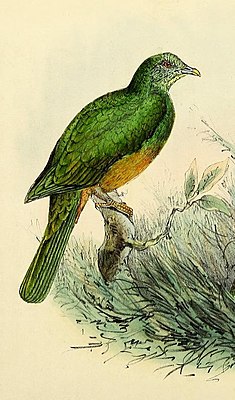Scarlet Breast Pigeon
| Scarlet Breast Pigeon | ||||||||||
|---|---|---|---|---|---|---|---|---|---|---|

Scarlet Breast Pigeon ( Ptilinopus bernsteinii ) |
||||||||||
| Systematics | ||||||||||
|
||||||||||
| Scientific name | ||||||||||
| Ptilinopus amberii | ||||||||||
| Schlegel , 1863 |
The scarlet breast fruit pigeon ( Ptilinopus bernsteinii ) is a species of pigeon birds that is one of the so-called fruit pigeons . It occurs on some Indonesian islands.
The population of the scarlet breast pigeon was classified in the IUCN's Red List of Threatened Species in 2016 as “ Least Concern (LC) ” = “not endangered”.
Appearance
The scarlet breast fruit pigeon reaches a body length of 29 centimeters. This makes it a medium-sized pigeon with a comparatively long tail. The tail accounts for between 10.8 and 12.4 centimeters. The beak is between 1.4 and 1.7 centimeters long. The sexual dimorphism is only very slight.
Appearance of the males
The front of the head and the crown are gray-green. The mantle and the small wing-coverts are bright green. The middle and large elytra are blue-green. The arm wings and the hand wings are black with a greenish tinge on the outer flags. The back and the upper tail-coverts are bright green. The tail is blue-green with a slight sheen.
The chin and throat and the ear covers are gray-green with a yellowish tinge. The front chest is light green and turns into a darker green towards the rear chest. There is a bright scarlet spot in the lower center of the chest. At the top, this spot is bordered by a dark purple band. The belly is yellow-orange and then turns into dark red-brown under tail coverts. The thighs and the feathered legs are green. The beak is pale green with a yellowish beak tip.
Appearance of the females
The females resemble the males in their plumage, but the head is greener. The scarlet stain found on males is missing on the chest. The belly of the females is also somewhat darker than that of the males.
Possible confusion
The blue-headed fruit pigeon also occurs in the distribution area of the scarlet breast pigeon . This is of a similar size, but is even more compact than the scarlet breast pigeon and has a very short tail. The head of this pigeon is gray and clearly separated from the green plumage. It also has a noticeable spot on the underside of the body. However, this one is purple, not scarlet, and is located in the abdominal region and not on the chest.
Distribution area and habitat
The scarlet breast pigeon is endemic to several Indonesian islands. It occurs on Bacan , Halmahera , Ternate , and the Obi Islands .
The habitat of the scarlet breast pigeon are rainforests. It occurs preferentially in primary forest, but can also be found in secondary forest if there is still primary forest nearby. Older literature describes the scarlet breast pigeon as a pigeon of the forests in foothills and mountains. According to more recent findings, however, it also occurs in forests in the lowlands and in investigations on Halmahera it was comparatively rare in mountain forests.
Way of life
The scarlet breast pigeon is a shy and inconspicuous species of pigeon that is usually observed solitary or in pairs. It usually resides in the upper treetop area. On Halmahera she is more forest-bound than other fruit pigeons and avoids crossing open terrain.
The breeding season falls from April to July. As is typical for pigeons, the nest is a loose platform made of twigs. This is built comparatively close to the ground in the top of a small tree. The clutch consists of a single egg.
literature
- David Gibbs, Eustace Barnes and John Cox: Pigeons and Doves - A Guide to the Pigeons and Doves of the World . Pica Press, Sussex 2001, ISBN 90-74345-26-3 .
- Gerhard Rösler: The wild pigeons of the earth - free living, keeping and breeding . M. & H. Schaper Verlag, Alfeld-Hannover 1996, ISBN 3-7944-0184-0 .
Web links
- Ptilinopus bernsteinii in the Red List of Threatened Species of the IUCN 2012. Posted by: BirdLife International, 2012. Accessed November 13, 2016th
Individual evidence
- ↑ a b Ptilinopus bernsteinii in the endangered Red List species the IUCN 2016 Posted by: BirdLife International, 2016. Retrieved on October 10, 2017th
- ↑ a b c Gibbs, Barnes and Cox: Pigeons and Doves , p. 469.
- ↑ Gibbs, Barnes and Cox: Pigeons and Doves , p. 470.